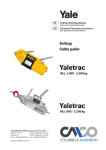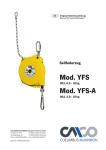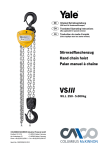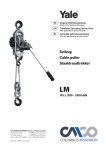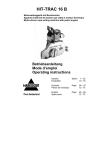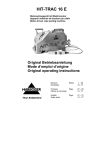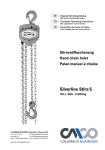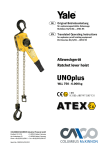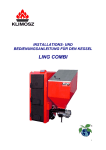Download Seilzug LP
Transcript
DE Original Betriebsanleitung EN Translated Operating Instructions (Gilt auch für Sonderausführungen) (Also applicable for special versions) Seilzug Cable puller LP W L L 500 kg Columbus McKinnon Industrial Products GmbH • D-42513 Velbert, Germany Postfach 10 13 24 • D-42549 Velbert, Germany Am Lindenkamp 31 Phone +49 (0) 20 51/600-0 • Fax +49 (0) 20 51/600-127 Ident.-No.: 09901120/03.2012 DE Seite 2 EN Page 5 Deutsch DE Vorwort Produkte der CMCO Industrial Products GmbH sind nach dem Stand der Technik und den anerkannten gültigen Regeln gebaut. Durch unsachgemäße Handhabungen können dennoch bei der Verwendung der Produkte Gefahren für Leib und Leben des Benutzers oder Dritter auftreten bzw. Beschädigungen am Hebezeug oder anderen Sachwerten entstehen. Das Bedienpersonal muss vor Arbeitsbeginn eingewiesen worden sein. Dazu ist die Betriebsanleitung von jedem Bediener vor der ersten Inbetriebnahme sorgfältig zu lesen. Diese Betriebsanleitung soll erleichtern, das Produkt kennenzulernen und die bestimmungsgemäßen Einsatzmöglichkeiten zu nutzen. Die Betriebsanleitung enthält wichtige Hinweise, um das Produkt sicher, sachgerecht und wirtschaftlich zu betreiben. Ihre Beachtung hilft Gefahren zu vermeiden, Reparaturkosten und Ausfallzeiten zu vermindern und die Zuverlässigkeit und Lebensdauer des Produktes zu erhöhen. Die Betriebsanleitung muss ständig am Einsatzort des Produktes verfügbar sein. Neben der Betriebsanleitung und den im Verwenderland und an der Einsatzstelle geltenden verbindlichen Regelungen zur Unfallverhütungsvorschrift sind auch die anerkannten Regeln für sicherheits- und fachgerechtes Arbeiten zu beachten. Das Personal für Bedienung, Wartung oder Reparatur des Produktes muss die Anweisungen in dieser Betriebsanleitung lesen, verstehen und befolgen. Die beschriebenen Schutzmaßnahmen führen nur dann zu der erforderlichen Sicherheit, wenn das Produkt bestimmungsgemäß betrieben und entsprechend den Hinweisen installiert bzw. gewartet wird. Der Betreiber ist verpflichtet, einen sicheren und gefahrlosen Betrieb zu gewährleisten. 2 von 16 Bestimmungsgemässe Verwendung - Das Gerät dient dem Heben, Senken, Ziehen, Spannen und Sichern von Lasten in beliebiger Lage und Richtung. Eine andere oder darüber hinausgehende Benutzung gilt als nicht bestimmungsgemäß. Für hieraus resultierende Schäden haftet Columbus McKinnon Industrial Products GmbH nicht. Das Risiko trägt allein der Anwender bzw. Betreiber. - Die auf dem Gerät angegebene Tragfähigkeit (WLL) ist die maximale Last, die angeschlagen werden darf. - Sollte das Hebezeug zum häufigen Ablassen aus großen Höhen oder im Taktbetrieb eingesetzt werden, ist zuvor mit dem Hersteller Rücksprache zu halten. - Die Auswahl und Bemessung der geeigneten Tragkonstruktion obliegt dem Betreiber. - Das Hebezeug muss zwischen Anschlagpunkt und Last so eingerichtet werden, dass es sich frei in Seil- und Zugkraftrichtung ausrichten kann. - Beim Einhängen des Gerätes ist vom Bediener darauf zu achten, dass das Hebezeug so bedient werden kann, dass der Bediener weder durch das Gerät selbst noch durch das Tragmittel oder die Last gefährdet wird. - Der Bediener darf eine Lastbewegung erst dann einleiten, wenn er sich davon überzeugt hat, dass die Last richtig angeschlagen ist und sich keine Personen im Gefahrenbereich aufhalten. - Der Aufenthalt unter einer angehobenen Last ist verboten. - Lasten nicht über längere Zeit oder unbeaufsichtigt in angehobenem oder gespanntem Zustand belassen. - Das Hebezeug kann in einer Umgebungstemperatur zwischen –10 °C und +50 °C eingesetzt werden. Bei Extrembedingungen muss mit dem Hersteller Rücksprache genommen werden. - Vor dem Einsatz des Hebezeuges in besonderen Atmosphären (hohe Feuchtigkeit, salzig, ätzend, basisch) oder der Handhabung gefährlicher Güter (z.B. feuerflüssige Massen, radioaktive Materialien) ist mit dem Hersteller Rücksprache zu halten. - Das Umlenken des Zugseils darf nur mit funktionsfähigen und ausreichend dimensionierten Seilflaschen (Umlenkrollen) erfolgen. - Bei der Verwendung von Zughaken und/ oder Anschlagseilen oder -ketten, ist auf die richtige Dimensionierung zu achten. - Zum Anschlagen einer Last dürfen nur zugelassene und geprüfte Anschlagmittel benutzt werden. - Zur bestimmungsgemäßen Verwendung gehört neben der Beachtung der Betriebsanleitung auch die Einhaltung der Wartungsanleitung. - Bei Funktionsstörungen oder abnormalen Betriebsgeräuschen ist das Hebezeug sofort außer Betrieb zu setzen. Sachwidrige Verwendung (nicht vollständige Auflistung) - Die Tragfähigkeit des Gerätes (WLL) bzw. des Tragmittels sowie der Tragkonstruktion darf nicht überschritten werden. - Es ist verboten, eine Last in das schlaffe Seil fallen zu lassen - Gefahr des Seilbruchs! - Das Entfernen oder Verdecken von Beschriftungen (z.B. durch Überkleben), Warnhinweisen oder dem Typenschild ist untersagt. - Beim Transport der Last ist eine Pendelbewegung (Fig. 1) und das Anstoßen an Hindernisse zu vermeiden. - Die Last darf nicht in Bereiche bewegt werden, die für den Bediener nicht einsehbar sind. Nötigenfalls hat er sich um Hilfestellung zu bemühen. - Motorischer Antrieb des Gerätes ist verboten. - Eine Hebelverlängerung ist nicht statthaft (Fig. 2). Es dürfen nur Original-Handhebel verwendet werden. - Das Gerät darf niemals mit mehr als der Kraft einer Person bedient werden. - Schweißarbeiten an Haken und Seil sind verboten. Das Seil darf nicht als Erdungsleitung bei Schweißarbeiten verwendet werden (Fig. 3). - Schrägzug, d.h. seitliche Belastungen des Gehäuses und/oder des Lasthakens, ist verboten (Fig. 4). Immer in einer geraden Linie zwischen beiden Haken und/oder Anschlagbolzen heben/ziehen/spannen. - Nur Original-Anschlagbolzen verwenden - niemals andere Anschlagmittel (als den zum Gerät gehörenden Anschlagbolzen) in die Aufnahmebohrungen einsetzen. - Ein ohne Rücksprache mit dem Hersteller verändertes Gerät darf nicht benutzt werden. - Die Benutzung des Hebezeuges zum Transport von Personen ist verboten (Fig. 5). - Das Seil darf nicht als Anschlagseil (Schlingseil) verwendet werden (Fig. 6). - Seil nicht knoten oder mit Seilklemmen, Schrauben oder Ähnlichem verkürzen oder verlängern (Fig. 7). Seile dürfen nicht instandgesetzt werden. - Das Seil nicht über Kanten ziehen. - Das Entfernen der Sicherheitsbügel von Trag- bzw. Lasthaken ist verboten (Fig. 8). - Hakenspitze nicht belasten (Fig. 9). Das Anschlagmittel muss immer im Hakengrund aufliegen. - Die aufgenommene Last darf sich nicht drehen, denn das Zugseil und der Lasthaken des Gerätes sind nicht zum Drehen von angehängten Lasten konzipiert. Ist ein betriebsmäßiges Drehen vorgesehen, müssen sog. Drallfänger eingesetzt werden bzw. es ist mit dem Hersteller Rücksprache zu halten. Es darf sich keine Drallbildung im Seil einstellen. - Es ist darauf zu achten, dass der Anschlagbolzen vollständig durch die Aufnahmen gesteckt wurde und mit der selbstsichernden Mutter (Fig. 10) gesichert wurde. - Sollte die zu ziehende/spannende/hebende Last mittels eines Hakens am Anschlagbolzen angeschlagen werden, so ist unbedingt darauf zu achten, dass der Anschlagbolzen korrekt im Hakengrund aufgenommen wird, der Haken also nicht zu groß gewählt wurde. - Beim Einsatz des Gerätes darf das lose Zugseilende beim Ablassen/Entlasten und das Hakenende beim Anheben/Ziehen das Gerät nicht erreichen. - Das lose Zugseilende darf nicht zum Anschlagen von Lasten verwendet werden. - Die beiden Aufnahmebohrungen für den Anschlagbolzen dürfen nicht zum Anschlagen von Haken, Seilen, Ketten oder Bändern verwendet werden. - Der Backenöffnungshebel darf nicht betätigt werden, wenn das Gerät unter Last steht. - Befindet sich das Hebezeug unter Last, ist es verboten, den Seilvorschub- und den Seilrückzughebel gleichzeitig zu betätigen. - Bei der Verwendung von Zugseilen ist auf die richtige Dimensionierung zu achten. Es sind die Grundsätze für Seiltriebe DIN 15020 zu beachten. - Mit dem Lastaufnahmemittel darf jeweils nur eine Last transportiert werden. - Niemals in bewegliche Teile greifen. - Gerät nicht aus großer Höhe fallen lassen. Es sollte immer sachgemäß auf dem Boden abgelegt werden. - Das Gerät darf nicht in explosionsfähiger Atmosphäre eingesetzt werden. Prüfung vor der ersten Inbetriebnahme Vor der ersten Inbetriebnahme, vor der Wiederinbetriebnahme und nach grundlegenden Änderungen ist das Produkt einschließlich der Tragkonstruktion einer Prüfung durch eine befähigte Person* zu unterziehen. Diese Prüfung besteht im Wesentlichen aus einer Sicht- und Funktionsprüfung. Diese Prüfungen sollen sicherstellen, dass sich das Hebezeug in einem sicheren Zustand befindet, ordnungsgemäß aufgestellt und betriebsbereit ist und gegebenenfalls Mängel bzw. Schäden festgestellt und behoben werden. *Als befähigte Personen können z.B. die Wartungsmonteure des Herstellers oder Lieferanten angesehen werden. Der Unternehmer kann aber auch entsprechend ausgebildetes Fachpersonal des eigenen Betriebes mit der Prüfung beauftragen. ACHTUNG: Beim Umgang mit Drahtseilen sollten Schutzhandschuhe getragen werden. Prüfung vor Arbeitsbeginn Vor jedem Arbeitsbeginn ist das Gerät einschließlich der Tragmittel, Ausrüstung und Tragkonstruktion auf augenfällige Mängel und Fehler wie z.B. Verformungen, Anrisse, Verschleiß und Korrosionsnarben zu überprüfen. Weiterhin sind die Bremse und das korrekte Einhängen des Gerätes und der Last zu überprüfen. Bremsfunktion prüfen Vor Arbeitsbeginn unbedingt die Funktion der Bremse prüfen: Dazu ist mit dem Gerät eine Last über eine kurze Distanz zu heben, zu ziehen oder zu spannen und wieder abzusenken bzw. zu entlasten. Beim Loslassen des Handhebels muss die Last in jeder beliebigen Position gehalten werden. ACHTUNG: Bei Funktionsstörung der Bremse ist das Gerät sofort außer Betrieb zu setzen und Rücksprache mit dem Hersteller zu halten! Überprüfung des Hebezeugs Auf ausreichende Schmierung der Mechanik achten. Möglichst vor jedem Arbeitsbeginn und nötigenfalls auch im Verlauf längerer Arbeiten die Klemmbackenpaare mit dickflüssigem Motoröl schmieren. Währenddessen den Seilvorschub- und den Seilrückzughebel mehrmals bewegen. Überprüfung des Anschlagpunktes - Der Anschlagpunkt für das Hebezeug ist so zu wählen, dass die Tragkonstruktion, an der es montiert werden soll, eine ausreichende Stabilität besitzt und die zu erwartenden Kräfte sicher aufgenommen werden können. - Es ist dafür zu sorgen, dass sich das Gerät auch unter Last frei ausrichten kann, da sonst unzulässige Zusatzbelastungen auftreten können. - Die Auswahl und Bemessung der geeigneten Tragkonstruktion obliegt dem Betreiber. ACHTUNG: Beim Einsatz des Hebezeugs im Zusammenspiel mit Umlenkrollen (Flaschenzugprinzip) kann ein Mehrfaches des Lastgewichts auf die Tragkonstruktion einwirken! Überprüfung des Seils ACHTUNG: Beim Umgang mit Drahtseilen sollten Schutzhandschuhe getragen werden. Das Seil muss auf äußere Fehler, Verformungen, Knicke, Brüche einzelner Drähte oder Litzen, Quetschungen, Aufdoldungen, Rostschäden (z.B. Korrosionsnarben), starke Überhitzung und starke Abnutzung der Seilendverbindungen (z.B. der Presshülse) überprüft werden. Seilschäden können zu Funktionsstörungen und bleibenden Schäden am Seilzug führen. Durch hervorstehende, gebrochene Seildrähte kann es zu Verletzungen kommen. Werden bereits leichte (noch nicht zur Ablegereife führende) Beschädigungen festgestellt, sind die Kontrollabstände zu verkürzen. Überprüfung des Trag- und Lasthakens Der Trag- und Lasthaken muss auf Risse, Verformungen, Beschädigungen, Abnutzung und Korrosionsnarben überprüft werden. Der Sicherheitsbügel muss leichtgängig und voll funktionsfähig sein. Überprüfung des Anschlagbolzens Der Anschlagbolzen muss auf Risse, Verformungen, Beschädigungen, Abnutzung und Korrosionsnarben überprüft werden. Funktion / Betrieb Einführung des Drahtseils - Es dürfen nur Original Yale-Zugseile mit dem zum Hebezeug passenden Nenndurchmesser verwendet werden. - Das Zugseil ist immer lagegerecht von der Haspel abzurollen, um Seilschlingen zu vermeiden, die zur Beschädigung des Seiles führen können. - Seilvorschubhebel und Seilrückzughebel in vorderste Position (in Richtung Anschlagbolzen) bringen. - Backenöffnungshebel in Pfeilrichtung drücken, dass er über die Gehäusewand gleitet, bis er hör- und spürbar in der oberen Endposition einrastet (Klemmbacken geöffnet). Das Umlegen des Backenöffnungshebels geht erheblich leichter, wenn man das Gerät hochkant auf den Anschlagbolzen stellt und den Hebel somit nach unten drückt (Hebel nur per Hand umlegen, niemals mit einem Hammer schlagen). - Das angespitzte Ende des Zugseils gemäß Gerätetyp in die Seileinführungshülse (Fig. 10) stecken und durch das Klemmbackensystem schieben bis die Arbeitsposition erreicht ist. - Den Backenöffnungshebel durch einen leichten Schlag wieder aus der Endraste herausdrücken (Vorsicht, Verletzungsgefahr). Dadurch werden die Klemmbacken geschlossen und das Gerät ist einsatzbereit. 3 von 16 Seilfreischaltung Durch Betätigen des Backenöffnungshebels (Fig. 10) werden die Klemmbacken geöffnet und das Zugseil kann schnell und bequem vorgespannt sowie nach Beenden der Arbeit aus dem Gerät gezogen werden. ACHTUNG: Backenöffnungshebel nur im unbelasteten/ungespannten Zustand betätigen! Erhöhung der Tragfähigkeit durch Umlenkrollen (z.B. Yale Drahtseilkloben) Ist die einfache maximale Nenntragfähigkeit im direkten Zug nicht ausreichend, so kann sie durch Umlenkrollen/Drahtseilkloben im Flaschenzugprinzip vervielfacht werden. So wird die Last auf mehrere Seilstränge verteilt. Dabei sind folgende Bedingungen zu erfüllen: - Eine befähigte Person hat die ausreichende Tragfähigkeit der Umlenkrolle festzustellen. - Die Umlenkrolle muss eine Vorrichtung haben, die unbeabsichtigtes Öffnen verhindert. - Die Umlenkrolle muss für denselben Temperaturbereich ausgelegt sein wie das Hebezeug. - Es dürfen nur Haken mit Sicherheitsbügel verwendet werden. - Der Durchmesser der Umlenkrolle muss mindestens das 12fache des Seil-Nenndurchmessers betragen. - Die Rillentiefe der Umlenkrolle muss mindestens das 1,5fache des Seil-Nenndurchmessers betragen. - Die Umlenkrolle muss mit einer Seilführungseinrichtung ausgestattet sein, die sicherstellt, dass das Zugseil auch bei Schlaffseilbildung in der Umlenkrollenrille verbleibt. Heben/Ziehen/Spannen - Handhebel bzw. Teleskophandhebel auf Seilvorschubhebel (Fig. 10) stecken und durch Drehung sichern. - Pumpbewegungen mit möglichst großem Hebelweg durchführen. - Es ist darauf zu achten, dass das Zugseil das Gerät auf der Anschlagbolzenseite frei und ungehindert verlassen kann. - Das unbelastete, freie Seil ist geordnet am Gerät zu führen (Austritt des Seils am Anschlagbolzen). Ein ungeordnetes Seil kann zu Funktionsstörungen führen und ein Sicherheitsrisiko darstellen. Senken/Entlasten - Handhebel bzw. Teleskophandhebel auf Seilrückzughebel (Fig. 10) stecken und durch Drehung sichern. - Senkvorgang durch Pumpbewegungen mit möglichst großem Hebelweg durchführen. 4 von 16 Überlastsicherung Um Beschädigungen des Hebezeuges durch zu große Kräfte zu verhindern, ist die Kraftübertragung vom Vorschubhebel auf das Gerät durch einen Abscherstift begrenzt. Er schert bei Überlastung ab. Ein neuer Abscherstift (im Handhebelgriff bzw. Tragegriff) kann auch unter Last eingesetzt werden. Dazu die Stiftreste mit einem Durchschlag entfernen und neuen Abscherstift mit einem Hammer vorsichtig einschlagen. Es dürfen nur Original YALE-Abscherstifte verwendet werden. Mit abgeschertem Stift ist ein Ab- bzw. Nachlassen der Last weiterhin jederzeit möglich. Prüfung, Wartung UND REPARATUR Laut bestehenden nationalen/internationalen Unfallverhütungs- bzw. Sicherheitsvorschriften müssen Hebezeuge •gemäß der Gefahrenbeurteilung des Betreibers, •vor der ersten Inbetriebnahme, •vor der Wiederinbetriebnahme nach Stilllegung, •nach grundlegenden Änderungen, •jedoch mindestens 1 x jährlich durch eine befähigte Person geprüft werden. ACHTUNG: Die jeweiligen Einsatzbedingungen (z.B. in der Galvanik) können kürzere Prüfintervalle notwendig machen. Reparaturarbeiten dürfen nur von Fachwerkstätten, die Original Yale Ersatzteile verwenden, durchgeführt werden. Die Prüfung (im Wesentlichen Sicht- und Funktionsprüfung) hat sich auf die Vollständigkeit und Wirksamkeit der Sicherheitseinrichtungen sowie auf den Zustand des Gerätes, der Tragmittel, der Ausrüstung und der Tragkonstruktion hinsichtlich Beschädigung, Verschleiß, Korrosion oder sonstigen Veränderungen zu erstrecken. Die Inbetriebnahme und die wiederkehrenden Prüfungen müssen dokumentiert werden (z.B. in der CMCO-Werksbescheinigung). Auf Verlangen sind die Ergebnisse der Prüfungen und die sachgemäße Reparaturdurchführung nachzuweisen. Ist das Hebezeug (ab 1 t Hubgewicht) an oder in einem Handfahrwerk eingebaut, oder wird mit dem Hebezeug eine gehobene Last in eine oder mehrere Richtungen bewegt, wird die Anlage als Kran betrachtet und es sind ggf. weitere Prüfungen durchzuführen. Lackbeschädigungen sind auszubessern, um Korrosion zu vermeiden. Alle Gelenkstellen und Gleitflächen sind leicht zu schmieren. Bei starker Verschmutzung ist das Gerät zu reinigen. Spätestens nach 10 Jahren muss das Gerät einer Generalüberholung unterzogen werden. Insbesondere die Maße des Drahtseils und des Last- bzw. Traghakens und des Anschlagbolzens bedürfen der Beobachtung. Sie sind mit den Tabellenmaßen (Tab. 1 - 3) zu vergleichen. ACHTUNG: Der Austausch von Bauteilen zieht zwangsläufig eine anschließende Prüfung durch eine befähigte Person nach sich! Prüfung des Drahtseils - Das Seil muss auf äußere Fehler, Verformungen, Knicke, Brüche einzelner Drähte oder Litzen, Quetschungen, Aufdoldungen, Rostschäden (z.B. Korrosionsnarben), starke Überhitzung und starke Abnutzung der Seilendverbindungen (z.B. der Presshülse) überprüft werden. - Aus Sicherheitsgründen muss ein Drahtseil ausgewechselt werden, wenn die Drahtbrüche in den Außenlitzen eine vorgegebene Anzahl übersteigt. Gezählt wird über eine Seillänge von 11- bzw. 30- mal dem Seildurchmesser. Die maximal erlaubte Anzahl gebrochener Litzen ist Tab. 4 zu entnehmen. - Das Drahtseil muss sofort ausgewechselt werden, wenn eine Litze vollständig gebrochen, das Seil verformt, geknickt, gestaucht oder in irgendeiner anderen Weise beschädigt oder verschlissen ist! - Das Drahtseil hat die Ablegereife erreicht, wenn sich durch Strukturveränderungen der Seildurchmesser auf längeren Strecken um 10 % oder mehr gegenüber dem Nennmaß verringert hat. - Ebenso hat das Drahtseil die Ablegereife erreicht, wenn es sich (auch stellenweise) nur mit erhöhtem Kraftaufwand durch die Klemmbacken des Hebezeuges schieben/ ziehen läßt. - Maßgebend für die Wartung und Prüfung des Drahtseiles sind die DIN 15020 Blatt 2 “Grundsätze für Seiltriebe, Überwachung und Gebrauch”, sowie die gültigen nationalen und internationalen Vorschriften des Betreiberlandes. - Ein ablegereifes Drahtseil ist durch ein Drahtseil gleicher Abmessungen und Güte zu ersetzen. Wartung des Drahtseils Das Drahtseil ist über seine gesamte Länge (also auch der Teil, der sich gerade im Hebezeug oder im Lastaufnahmemittel befindet) am Ende eines Einsatztages von grobem Schmutz zu befreien und erneut leicht einzufetten, um Korrosion vorzubeugen. Prüfung des Trag- und Lasthakens Die Prüfung der Haken auf Verformung, Beschädigungen, Oberflächenrisse, Abnutzung und Korrosion ist nach Bedarf, jedoch mindestens einmal im Jahr durchzuführen. Die jeweiligen Einsatzbedingungen können auch kürzere Prüfintervalle erforderlich machen. Haken, die laut Prüfung verworfen wurden, sind durch neue zu ersetzen. Schweißungen an Haken, z.B. zum Ausbessern von Abnutzung sind nicht zulässig. Trag- und/oder Lasthaken müssen ausgewechselt werden, wenn die Maulöffnung um 10% aufgeweitet ist (Fig. 11) oder wenn die Nennmaße durch Abnutzung um 5% abgenommen haben. Nennwerte und Verschleißgrenzen sind der nachstehenden Tabelle 2 zu entnehmen. Bei Erreichen der Grenzwerte sind die Bauteile auszuwechseln. Prüfung des Anschlagbolzens Die Prüfung des Anschlagbolzens auf Verformung, Beschädigungen, Oberflächenrisse, Abnutzung und Korrosion ist nach Bedarf, jedoch mindestens einmal im Jahr durchzuführen. Die jeweiligen Einsatzbedingungen können auch kürzere Prüfintervalle erforderlich machen. Ein Anschlagbolzen, der laut Prüfung verworfen wurde, ist durch einen Neuen zu ersetzen. Schweißungen am Anschlagbolzen, z.B. zum Ausbessern von Abnutzung, sind nicht zulässig. Der Anschlagbolzen ist spätestens dann zu ersetzen, wenn sein Durchmesser um 5 % kleiner als der Nenndurchmesser (Tab. 3) ist. Reparaturen dürfen nur von autorisierten Fachwerkstätten, die Original YaleErsatzteile verwenden, durchgeführt werden. Nach einer erfolgten Reparatur sowie nach längerer Standzeit ist das Hebezeug vor der Wiederinbetriebnahme erneut zu prüfen. Die Prüfungen sind vom Betreiber zu veranlassen. Transport, Lagerung, AuSSerbetriebnahme und Entsorgung Beim Transport des Gerätes sind folgende Punkte zu beachten: •Gerät nicht stürzen oder werfen, immer vorsichtig absetzen. •Zugseil aus dem Gerät entfernen. •Das Drahtseil ist so zu transportieren, dass sie sich nicht verknoten kann und sich keine Schlaufen bilden können (z.B. auf einer Haspel). •Geeignete Transportmittel verwenden. Diese richten sich nach den örtlichen Gegebenheiten. Bei der Lagerung oder der vorübergehenden Außerbetriebnahme des Gerätes sind folgende Punkte zu beachten: •Das Gerät an einem sauberen und trockenen Ort lagern. •Das Gerät inkl. aller Anbauteile vor Verschmutzung, Feuchtigkeit und Schäden durch eine geeignete Abdeckung schützen. •Haken vor Korrosion schützen. •Das Seil ist durch Einfetten vor Korrosion zu schützen. •Soll das Gerät nach der Außerbetriebnahme wieder zum Einsatz kommen, ist es zuvor einer erneuten Prüfung durch eine befähigte Person zu unterziehen. Entsorgung: Nach Außerbetriebnahme sind die Teile des Gerätes entsprechend den gesetzlichen Bestimmungen der Wiederverwertung zuzuführen bzw. zu entsorgen. Weitere Informationen und Betriebsanleitungen zum Download sind unter www.cmco.eu zu finden! English EN Introduction Products of CMCO Industrial Products GmbH have been built in accordance with the stateof-the-art and generally accepted engineering standards. Nonetheless, incorrect handling when using the products may cause dangers to life and limb of the user or third parties and/or damage to the hoist or other property. The operating company is responsible for the proper and professional instruction of the operating personnel. For this purpose, all operators must read these operating instructions carefully prior to the initial operation. These operating instructions are intended to acquaint the user with the product and enable him to use it to the full extent of its intended capabilities. The operating instructions contain important information on how to operate the product in a safe, correct and economic way. Acting in accordance with these instructions helps to avoid dangers, reduce repair costs and downtimes and to increase the reliability and lifetime of the product. The operating instructions must always be available at the place where the product is operated. Apart from the operating instructions and the accident prevention act valid for the respective country and area where the product is used, the commonly accepted regulations for safe and professional work must also be adhered to. The personnel responsible for operation, maintenance or repair of the product must read, understand and follow these operating instructions. The indicated protective measures will only provide the necessary safety, if the product is operated correctly and installed and/or maintained according to the instructions. The operating company is committed to ensure safe and trouble-free operation of the product. Correct operation - The unit is used for lifting, lowering, pulling, tensioning and securing of loads in any position and any direction. - Any different or exceeding use is considered incorrect. Columbus McKinnon Industrial Products GmbH will not accept any liability for damage resulting from such use. The risk is borne by the user or operating company alone. - The load capacity indicated on the unit is the maximum working load limit (WLL) that may be attached. - If the hoist is to be used for frequent lowering from large heights or in indexed operation, first consult the manufacturer for advice. 5 von 16 - The selection and calculation of the appropriate supporting structure are the responsibility of the operating company. - The hoist must be arranged between attachment point and load in such a way that it can freely align in the direction of the rope and pulling force. - The operator must ensure that the hoist is suspended in a manner that makes it possible to operate the unit without exposing himself or other personnel to danger by the unit itself, the suspension or the load. - The operator may start moving the load only after it has been attached correctly and all persons are clear of the danger zone. - Do not allow personnel to stay or pass under a suspended load. - A lifted or clamped load must not be left unattended or remain lifted or clamped for a longer period of time. - The hoist may be used at ambient temperatures between –10 °C and +50 °C. Consult the manufacturer in the case of extreme working conditions. - Prior to operation of the hoist in special atmospheres (high humidity, salty, caustic, alkaline) or handling hazardous goods (e.g. molten compounds, radioactive materials), consult the manufacturer for advice. - The rope must only be returned by means of fully functional and sufficiently dimensioned rope pulleys (return pulleys). - When hooks and/or rope slings or chains are used, it must be ensured that they are correctly dimensioned. - For attaching a load, only approved and certified lifting tackle must be used. - Correct operation involves compliance with the operating instructions and in addition also compliance with the maintenance instructions. - In case of functional defects or abnormal operating noise, stop using the hoist immediately. Incorrect operation (List not complete) - Do not exceed the rated load capacity (WLL) of the unit and/or the suspension and the supporting structure. - It is prohibited to allow the load to fall into the slack rope – danger of rope rupture! - Removing or covering (e.g. by adhesive labels) labels, warning information signs or the identity plate is prohibited. - When transporting loads ensure that the load does not swing (Fig. 1) or come into contact with other objects. - The load must not be moved into areas which are not visible to the operator. If necessary, 6 von 16 he must ensure he is given help. - Driving the unit with a motor is not allowed. - The lever must not be extended (Fig. 2). Only original hand levers must be used. - The unit must never be operated with more than the power of a person. - Welding on hook and rope is strictly forbidden. The rope must never be used as a ground connection during welding (Fig. 3). - Side pull, i. e. side loading of the housing and/or the load hook (Fig. 4) is forbidden. Always lift/pull/tension within a straight line between both hooks and/or anchor bolts. - Only use original anchor bolts – never insert any other lifting tackle (than the anchor bolt which belongs to the unit) into the mounting holes. - A unit changed without consulting the manufacturer must not be used. - Do not use the hoist for the transportation of people (Fig. 5). - The rope must not be used as a rope sling (Fig. 6). - Do not tie knots in the rope or extend or shorten it by using rope clamps, screws or similar (Fig. 7). Ropes must not be repaired. - Do not pull the rope over edges. - Removing the safety latches from top resp. load hooks is forbidden (Fig. 8). - Never attach the load to the tip of the hook (Fig. 9). The lifting tackle must always be seated in the saddle of the hook. - The load must not be allowed to revolve around its own axis, since the rope and the load hook of the unit have not been designed for turning attached loads. If loads must be turned in normal operation, an anti-twist swivel must be used or the manufacturer must be consulted. The rope must not twirl. - Make sure that the anchor bolt has been fully pushed through the mounting holes and secured with the self-locking nut (Fig. 10). - If the load to be pulled/tensioned/lifted is attached to the anchor bolt by means of a hook, always make sure that the anchor bolt is correctly seated in the saddle of the hook, i.e. the hook size selected is not too large. - When the unit is in operation, the loose end of the rope must not reach the unit while lowering/unloading; the hook end must not reach it while lifting/pulling. - The loose end of the rope must not be used for attaching loads. - The two mounting holes for the anchor bolt must not be used for attaching hooks, ropes, chains or belts. - The clamping jaw lever must not be actuated, when the unit is under load. - If the hoist is under load, it is prohibited to actuate the forward lever and the reversing lever at the same time. - When ropes are used, it must be ensured that they are correctly dimensioned. The principles laid down in DIN 15020 for rope drive arrangements must be complied with. - Only one load may be transported at a time with the load lifting attachment. - Never reach into moving parts. - Do not allow the unit to fall from a large height. Always place it properly on the ground. - The unit must not be used in potentially explosive atmospheres. Inspection before initial operation Prior to initial operation, before it is put into operation again and after substantial changes, the product including the supporting structure must be inspected by a competent person*. The inspection mainly consists of a visual inspection and a function check. These inspections are intended to establish that the hoist is in a safe condition, has been set up appropriately and is ready for operation and that any defects or damage are detected and eliminated, as required. *Competent persons may be, for example, the maintenance engineers of the manufacturer or the supplier. However, the company may also assign performance of the inspection to its own appropriately trained specialist personnel. ATTENTION: Always wear protection gloves for handling wire ropes. Inspections before starting work Before starting work, inspect the unit including the suspension, equipment and supporting structure for visual defects, e. g. deformations, damage, cracks, wear and corrosion marks. In addition also test the brake and check that the hoist and the load are correctly attached. Checking the brake function Before starting work, always check operation of the brake: To do this, lift, pull or tension and lower or release a load over a short distance with the unit. When the hand lever is released, the load must be held in any position. ATTENTION: If the brake does not function properly, the unit must be immediately taken out of service and the manufacturer must be contacted! Inspection of the hoist Make sure the mechanical equipment is sufficiently lubricated. Each time before starting work and, if necessary, also in the course of longer work, lubricate the clamping jaw pairs with thick motor oil. Actuate the forward lever and the reversing lever several times for lubricating. Inspection of the attachment point - The attachment point for the hoist must be selected so that the supporting structure to which it is to be fitted has sufficient stability and to ensure that the expected forces can be safely absorbed. - The unit must align freely also under load in order to avoid impermissible additional loading. - The selection and calculation of the appropriate supporting structure are the responsibility of the operating company. ATTENTION: When the hoist is used in combination with return pulleys (pulley block principle), a multiple of the load weight may act on the supporting structure! Inspection of the rope ATTENTION: Always wear protection gloves for handling wire ropes. Check the rope for outer defects, deformations, kinks, broken individual wires or strands, crushing, swelling, rust damage (e.g. corrosion marks), strong overheating and heavy wear of the rope end connections (e.g. pressure sleeve). Rope damage may result in malfunctions and lasting damage to the cable puller. Protruding, broken wires may cause injuries. If slight damage (not yet resulting in discarding of the rope) is determined, the inspection intervals must be shortened. Inspection of the top hook and load hook The top and load hooks must be checked for cracks, deformations, damage, wear and corrosion marks. The safety latch must move freely and be fully functioning. Inspection of the anchor bolt The anchor bolt must be checked for cracks, deformations, damage, wear and corrosion marks. Function / OPERATION Inserting the wire rope - Only original Yale ropes with the nominal diameter suitable for the hoist may be used. - Always roll out the rope from the reel in the correct position, in order to avoid rope slings which may result in damage to the rope. - Place the forward and reversing levers in the front position (in the direction of the anchor bolt). - Push the clamping jaw lever in the direction of the arrow, so that it passes over the housing body, until you hear it noticeably snaps into the upper end position (clamping jaws open). To facilitate movement of the clamping jaw lever, position the unit upright on the anchor bolt and thus push down the lever (only move the lever by hand, never hit with a hammer). - Enter the pointed end of the wire rope according to the model type into the rope entry sleeve (Fig. 10), slide it through the clamping jaws and feed it through until the working position is reached. - Push the clamping jaw lever out of the lock again by striking it with a slight stroke (Caution: danger of injury). This closes the clamping jaws and the unit is ready for operation. Releasing the rope Actuate the clamping jaw lever (Fig. 10) to open the clamping jaws; the rope can be tensioned easily and quickly and also be pulled out of the unit when work has been completed. ATTENTION: Only actuate the clamping jaw lever in no-load/no-tension condition! Increasing the load capacity by return pulleys (e.g. Yale wire rope blocks) If the single max. nominal load capacity in direct pull is not sufficient, it can be multiplied by the use of return pulleys/wire rope blocks based on the pulley block principle. The load is then distributed to several rope falls. The following requirements must be fulfilled: - A competent person must establish that the load capacity of the return pulley is adequate. - The return pulley must be provided with a device which prevents unintended opening. - The return pulley must be rated for the same temperature range as the hoist. - Only use hooks with a safety latch. - The diameter of the return pulley must be at least 12 times the nominal rope diameter. - The groove depth of the return pulley must be at least 1.5 times the nominal rope diameter. - The return pulley must be provided with a rope guide ensuring that the rope remains in the groove of the return pulley also in the event of slack rope. Lifting/pulling/tensioning - Place the (telescopic) handle over the forward lever (Fig. 10) and rotate till it engages. - Operate the unit with a pumping action, where possible use full strokes. - Make sure that the rope can leave the unit on the anchor bolt side freely and without any obstruction. - Guide the unloaded free rope on the unit (exit of rope on anchor bolt). An insufficiently guided rope may lead to malfunctions and represent a safety risk. Lowering/unloading - Place the (telescopic) handle over the reverse movement lever (Fig. 10) and rotate till it engages. - Operate the unit for lowering with a pumping action, where possible use full strokes. Overload protection In order to avoid damage to the hoist by excessive forces, the transmission of power from the forward lever to the unit is limited by means of a shear pin. It shears when overload is applied. A new shear pin (stored in the carrying handle or lever grip) can also be fitted under load. To do this, remove pin remainders with a drift and carefully drive in the new shear pin using a hammer. Only original Yale shear pins must be used. Lowering of the load is always still possible with shorn pin. Inspection, maintenance AND REPAIR According to national and international accident prevention and safety regulations hoisting equipment must be inspected: •in accordance with the risk assessment of the operating company, •prior to initial operation, •before the unit is put into service again following a shut down, •after substantial changes, •however, at least once per year, by a competent person. ATTENTION: Actual operating conditions (e.g. operation in galvanizing facilities) can dictate shorter inspection intervals. Repair work may only be carried out by a specialist workshop that uses original Yale spare parts. The inspection (mainly consisting of a visual inspection and a function check) must determine that all safety devices are complete and fully operational and cover the condition of the unit, suspension, equipment and supporting structure with regard to damage, wear, corrosion or any other alterations. Initial operation and recurring inspections must be documented (e.g. in the CMCO works certificate of compliance). If required, the results of inspections and appropriate repairs must be verified. If the hoist (from 1 t lifting weight) is fitted on or in a trolley and the hoist is used to move a lifted load in one or several directions, the installation is considered to be a crane and the further inspections must be carried out if applicable. Paint damage should be touched up in order to avoid corrosion. All joints and sliding surfaces should be slightly greased. In the case of heavy contamination, the unit must be cleaned. The unit must be given a general overhaul after 10 years, at the latest. 7 von 16 In particular, check the dimensions of the wire rope, the load resp. top hook and the supporting pin. They must be compared with the dimensions specified in the table 1 - 3. ATTENTION: After the replacement of components, a subsequent inspection by a competent person is obligatory! Inspection of the wire rope - Check the rope for outer defects, deformations, kinks, broken individual wires or strands, crushing, swelling, rust damage (e.g. corrosion marks), strong overheating and heavy wear of the rope end connections (e.g. pressure sleeve). - For safety reasons, wire ropes must be replaced when the number of broken wires in the outer strands exceeds a defined quantity. This is counted over a reference length of rope 11 times or 30 times the rope diameter. The max. permissible number of broken strands is specified in Tab. 4. - The wire rope must be replaced immediately, if a strand is completely broken, the rope is deformed, kinked, compressed or damaged or worn in any other way! - The wire rope must be discarded, if the rope diameter has reduced on longer sections by 10 % or more compared with the nominal dimension. - The wire rope must also be discarded, if it can only be pushed/pulled with increased effort through the clamping jaws of the hoist (even if only at certain points). - DIN 15020 sheet 2 “Principles Relating to Rope Drives; Supervision during Operation” and the relevant international and national regulations of the country of use are definitive for the maintenance and inspection of wire ropes. - A worn wire rope must be replaced by a wire rope with the same dimensions and the same quality. Maintenance of the wire rope At the end of the working day, clean the wire rope from coarse dirt over its entire length (i.e. including the part which is in the hoist or in the load lifting attachment) and slightly regrease it in order to prevent corrosion. 8 von 16 Inspection of the top and load hook Inspect the hook for deformation, damage, surface cracks, wear and signs of corrosion, as required, but at least once a year. Actual operating conditions may also dictate shorter inspection intervals. Hooks that do not fulfil all requirements must be replaced immediately. Welding on hooks, e.g. to compensate for wear or damage is not permissible. Top and/or load hooks must be replaced when the mouth of the hook has opened more than 10 % (Fig. 11) or when the nominal dimensions have reduced by 5 % as a result of wear. Nominal dimensions and wear limits are shown in the following table 2. If the limit values are exceeded, replace the components. Inspection of the anchor bolt Inspect the anchor bolt for deformation, damage, surface cracks, wear and signs of corrosion as required but at least once a year. Actual operating conditions may also dictate shorter inspection intervals. If an anchor bolt must be discarded as a result of the inspection, a new anchor bolt must be fitted. Welding on anchor bolts, e.g. to compensate for wear or damage is not permissible. The anchor bolt must be replaced at the latest, if its material diameter is 5% smaller than the nominal diameter (Tab. 3). Repairs may only be carried out by authorized specialist workshops that use original Yale spare parts. After repairs have been carried out and after extended periods of non-use, the hoist must be inspected again before it is put into service again. The inspections have to be initiated by the operating company. Transport, Storage, take out of service and Disposal Observe the following for transporting the unit: •Do not drop or throw the unit, always deposit it carefully. •Remove the rope from the unit. •Wire ropes must be transported in a way to avoid knotting and formation of loops (e.g. on a reel). •Use suitable transport means. These depend on the local conditions. Observe the following for storing or temporarily taking the unit out of service: •Store the unit at a clean and dry place. •Protect the unit incl. all accessories against contamination, humidity and damage by means of a suitable cover. •Protect hooks against corrosion. •Protect the rope against corrosion by greasing. •If the unit is to be used again after it has been taken out of service, it must first be inspected again by a competent person. Disposal: After taking the unit out of service, recycle or dispose of the parts of the unit in accordance with the legal regulations. Further information and operating instructions are to be found at www.cmco.eu DE EN FR Sachwidrige Verwendung Incorrect operation Utilisations incorrectes Fig. 1 Fig. 2 Fig. 3 Fig. 4 Fig. 5 Fig. 6 Fig. 7 Fig. 8 Fig. 9 9 von 16 Beschreibung 1 Traghaken mit Sicherheitsbügel 2 Anschlagbolzen 3 Seilvorschubhebel 4 Abscherstift 5 Gehäuse 6 Seilrückzughebel 7 Seileinführungshülse 3 6 5 1 4 2 Description 1 Top hook with safety latch 2 Anchor bolt 3 Forward lever 4 Shear pin 5 Housing 6 Reversing lever 7 Rope entry sleeve 7 Fig. 10 Modell / Model / Modèle LP 500 Tragfähigkeit (Nennlast) Lifting capacity (rated load) Capacité de levage (charge nominale) Seilvorschub pro Doppelhub unbelastet Rope advance per full stroke cycle Avance par manipulation av./ar. du levier sans charge Hebelkraft bei Nennlast Lever pull at rated load Effort sur le levier à charge nominale Seildurchmesser dnom. Wire rope diameter d min. Diamètre du câble Tab. 1 10 von 16 [kg] 500 [mm] 35 [daN] 15 [mm] 8,3 [mm] 7,5 a h Fig. 11 b Hakenmaße / Hook dimensions / Dimensions du crochet LP LP 500 Hakenöffnungsmaß / Hook opening Ouverture du crochet anom. [mm] amax. [mm] 14,5 16,0 Maß Hakenbreite / Hook width Largeur du crochet bnom. [mm] bmin. [mm] 16,0 15,2 Maß Hakendicke / Hook height Hauteur du crochet hnom. [mm] hmin. [mm] 21,5 20,4 Tab. 2 Anschlagbolzenmaße / Anchor bolt dimensions LP LP 500 Anschlagbolzendurchmesser / Anchor bolt diameter dnom. [mm] 17,0 Anschlagbolzendurchmesser / Anchor bolt diameter dmin. [mm] 16,2 Tab. 3 Anzahl der sichtbaren Drahtbrüche bei Ablegereife/Discard number of wire breaks LP Seildurchmesser d / Rope diameter d Seilaufbau / Cross section Mindest-Bruchkraft / Min. breaking load [mm] [kN] Anzahl der sichtbaren Drahtbrüche bei Ablegereife auf einer Länge von 6d Discard number of wire breaks per 6d Anzahl der sichtbaren Drahtbrüche bei Ablegereife auf einer Länge von 30d Discard number of wire breaks per 30d LP 500 8,3 6x19S-IWRC 1470 sZ 34,3 3 6 Tab. 4 11 von 16 12 von 16 13 von 16 14 von 16 DE Original EG Konformitätserklärung 2006/42/EG (Anhang II A) Hiermit erklären wir, dass das nachstehend bezeichnete Produkt in seiner Konzipierung und Bauart sowie in der von uns in Verkehr gebrachten Ausführung den einschlägigen grundlegenden Sicherheits- und Gesundheitsanforderungen der EG-Richtlinien Maschinen entspricht. Bei einer nicht mit uns abgestimmten Änderung/Ergänzung des Produktes verliert diese EG-Konformitätserklärung ihre Gültigkeit. Weiterhin verliert diese EG-Konformitätserklärung ihre Gültigkeit, wenn das Produkt nicht entsprechend den in der Betriebsanleitung aufgezeigten bestimmungsgemäßen Einsatzfällen eingesetzt wird und die regelmäßig durchzuführenden Überprüfungen nicht ausgeführt werden. Produkt: Handhebezeug (Seilzug) Typ: Seilzug LP LP 500 Serien-Nr.: Seriennummern für die einzelnen Geräte werden archiviert Tragfähigkeit: 500 kg Einschlägige EG-Richtlinien: EG-Maschinenrichtlinie 2006/42/EG Angewandte Normen: ISO 12100:2010; EN 349:1993+A1:2008; DIN 15020-2:1974; DIN 15400:1990; DIN 15404-1:1989; BGV D 8; BGR 500 Qualitätssicherung: EN ISO 9001:2008 Firma / Dokumentationsbevollmächtigter: Columbus McKinnon Industrial Products GmbH Am Lindenkamp 31, 42549 Velbert, Germany EN Datum / Hersteller-Unterschrift: 20.03.2012 Angaben zum Unterzeichner: Dipl.-Ing. Andreas Oelmann Leiter Qualitätswesen Translation of the original EC Declaration of Conformity 2006/42/EC (Appendix II A) We hereby declare, that the design, construction and commercialised execution of the below mentioned products comply with the essential health and safety requirements of the EC Machinery Directive. The validity of this declaration will cease in case of any modification of or supplement to the products without our prior consent. Furthermore, validity of this EC declaration of conformity will cease in case that the products are not operated correctly and in accordance with the operating instructions and/or not inspected regularly. Product: Hand hoist (Cable puller) Type: Cable puller LP LP 500 Serial no.: Serial numbers for the individual units are recorded Relevant EC Directives: EC Machinery Directive 2006/42/EC Standards in particular: ISO 12100:2010; EN 349:1993+A1:2008; DIN 15020-2:1974; DIN 15400:1990; DIN 15404-1:1989; BGV D 8; BGR 500 Quality assurance: EN ISO 9001:2008 Capacity: 500 kg Company / Authorised representative for technical data: Columbus McKinnon Industrial Products GmbH Am Lindenkamp 31, 42549 Velbert, Germany 15 von 16 Germany United Kingdom Spain and Portugal COLUMBUS McKINNON Industrial Products GmbH* COLUMBUS McKINNON Corporation Ltd. COLUMBUS McKINNON Ibérica S.L.U. Knutsford Way, Sealand Industrial Estate Chester CH1 4NZ Phone: 00 44 (0) 1244375375 Web Site: www.cmco.eu E-mail: [email protected] Ctra. de la Esclusa, 21 acc. A 41011 Sevilla Phone: 00 34 954 29 89 40 Web Site: www.yaleiberica.com E-mail: [email protected] Unit 1A, The Ferguson Centre 57-59 Manse Road Newtownabbey BT36 6RW Northern Ireland Phone: 00 44 (0) 28 90 840697 Web Site: www.cmco.eu E-mail: [email protected] South Africa COLUMBUS McKINNON Engineered Products GmbH* Am Silberpark 2-8 86438 Kissing Phone: 00 49 (0) 8233 2121-800 Web Site: www.cmco.eu Web Site: www.pfaff-silberblau.com E-Mail: [email protected] Italy COLUMBUS McKINNON Italia S.r.l. Via P. Picasso, 32 20025 Legnano (MI) Phone: 00 39 (0) 331/57 63 29 Web Site: www.cmco.eu E-mail: [email protected] Dubai COLUMBUS McKINNON Industrial Products ME FZE Warehouse No. FZSBD01 P.O. Box 261013 Jebel Ali Dubai, U.A.E. Phone: 00 971 4 880 7772 Web Site: www.cmco.eu E-mail: [email protected] Netherlands COLUMBUS McKINNON Benelux B.V.* Grotenoord 30 3341 LT Hendrik Ido Ambacht Phone: 00 31 (0) 78/6 82 59 67 Web Site: www.yaletakels.nl E-mail: [email protected] China Hangzhou LILA Lifting and Lashing Co. Ltd.* Austria 3350 Nanhuan Road, Zhijiang Industrial Park Hangzhou High-tech Zone Zhejiang Province Phone: 00 86 10 85 23 63 86 Web Site: www.yale-cn.com E-mail: [email protected] Gewerbepark, Wiener Straße 132a 2511 Pfaffstätten Phone: 00 43 (0) 22 52/4 60 66-0 Web Site: www.yale.at E-mail: [email protected] COLUMBUS McKINNON (Hangzhou)* Industrial Products Co. Ltd. COLUMBUS McKINNON Austria GmbH* Poland COLUMBUS McKINNON Polska Sp. z o.o. No. 100 Luofeng Road Xiaoshan, Yiqiao, Zhejiang Province Postcode 311256 Phone: 00 86 10 85 23 63 86 Web Site: www.yale-cn.com E-mail: [email protected] Ul. Owsiana 14 62-064 PLEWISKA Phone: 00 48 (0) 61 6 56 66 22 Web Site: www.pfaff.info.pl E-Mail: [email protected] France COLUMBUS McKINNON Russia LLC Russia COLUMBUS McKINNON France SARL* Zone Industrielle des Forges 18108 Vierzon Cedex Phone: 00 33 (0) 248/71 85 70 Web Site: www.cmco-france.com E-mail: [email protected] Chimitscheski Pereulok, 1, Lit. AB Building 72, Office 33 198095 St. Petersburg Phone: 007 (812) 322 68 38 Web Site: www.yale.de E-mail: [email protected] CMCO Material Handling (Pty) Ltd.* P.O. Box 15557 Westmead, 3608 Phone: 00 27 (0) 31/700 43 88 Web Site: www.yale.co.za E-mail: [email protected] Yale Engineering Products (Pty) Ltd. 12 Laser Park Square, 34 Zeiss Rd. Laser Park Industrial Area, Honeydew Phone: 00 27 (0) 11/794 29 10 Web Site: www.yalejhb.co.za E-mail: [email protected] Yale Lifting & Mining Products (Pty) Ltd. P.O. Box 592 Magaliesburg, 1791 Phone: 00 27 (0) 14/577 26 07 Web Site: www.yale.co.za E-mail: [email protected] Thailand Yale Industrial Products Asia Co. Ltd. 54 BB.Building, Room No. 1510, 15th Floor, Sukhumvit 21 (Asoke) Road, Klongtoey Nua Wattana, Bangkok 10110 Phone: 00 66 (0) 26 64 03 00 Web Site: www.yale-thailand.com Turkey COLUMBUS McKINNON Kaldırma Ekip. San. ve Tic. Ltd. Şti. Davutpaşa Caddesi Emintaş Davutpaşa Matbaacılar Sitesi No. 103/233-234 34010 Topkapi-istanbul Phone: 00 90 (212) 210 7 555 Web Site: www.cmco.eu Hungary COLUMBUS McKINNON Hungary Kft. Vásárhelyi út 5. VI ép 8000 Székesfehérvár Phone: 00 36 (22) 546-720 Web Site: www.yale.de E-mail: [email protected] Switzerland COLUMBUS McKINNON Switzerland AG Dällikerstraße 25 8107 Buchs ZH Phone: 00 41 (0) 44 8 51 55 77 Web Site: www.cmco.ch E-mail: [email protected] *Diese Niederlassungen gehören der Matrix-Zertifizierung nach EN ISO 9001:ff an. *These subsidiaries belong to the matrix-certification-system according to EN ISO 9001:ff. Reproduktionen, gleich welcher Art, nur mit schriftlicher Genehmigung der COLUMBUS McKINNON Industrial Products GmbH! Reproduction of any kind, only with written authorisation of COLUMBUS McKINNON Industrial Products GmbH! Technische Änderungen vorbehalten. Keine Gewährleistung für Druckfehler oder Irrtümer – Subject to engineering changes and improvements. No warranty for printing errors or mistakes. Am Lindenkamp 31 42549 Velbert Phone: 00 49 (0) 20 51/600-0 Web Site: www.cmco.eu Web Site: www.yale.de E-mail: [email protected]
















